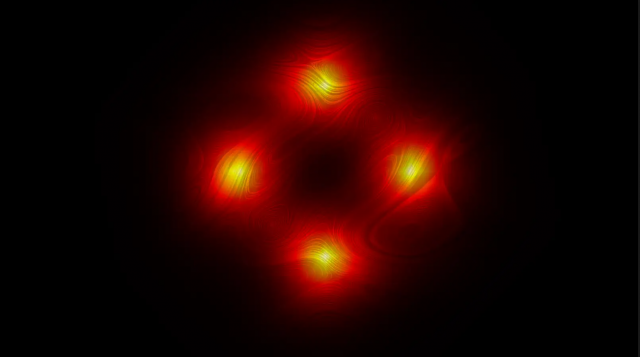
The Four Body Problem
Description
How can animal cells flow? Cells organize into thin, gapless sheets, like our skin, called tissues. This way, they can keep intruders at bay and make sure our body gets what it needs and gets rid of what it doesn't. At the same time, tissues need to flow—to heal wounds or shape our arms, legs, and eyes in a process called morphogenesis, meaning 'birth of shape' in Greek. But cells must move without leaving gaps. So how does one move without space? Cells solve this ingeniously. Imagine four cells in a square. Using their internal engines to convert energy to forces, they push against each-other, creating a single line of cells, moving in the opposite direction to which they push!
During this squishing, however, their shape changes. In motionless tissues, cells are mostly hexagonal (six sides), so, although our four cells start as hexagons, after squeezing passed each-other two of them become pentagons (five sides) and two of them heptagons (seven sides). In physics, a sheet of hexagons is called a honeycomb lattice. In that lattice, pentagons and heptagons are topological defects: objects that like electrons and protons have positive and negative charges that attract and repel. Finally, when the building blocks of the lattice can convert energy to forces, like cells, the lattice is called active.
We link moving cells in tissues to topological defects in active, melting lattices. This lets us study how cells flow by looking at the flows around defects. In this picture, we follow the squishing, shape-change, and flow of our four cells, by simulating the flows generated during the birth of two pentagons and two heptagons. The alternating pentagons and heptagon ``light-up'' in a hexagonal lattice (yellow lights), while the flow they create is corresponds to the streamline patterns around them.
Using a differential equation solver, I solve numerically the coupled Navier-Stokes equations, and hydrodynamic equations for the tensorial Hexatic order parameter. The flow is sourced by a Hexatic active stress, generated due to the distortion of the orientation field around and at the defect locations. The yellow light, correspond to the magnitude of the order parameter rapidly dropping to zero at the defect core. The streamline are generated by extrapolating the velocity field calculated in the simulation, using a fourth order Runge-kutta 4 method, in the program called ParaView. The two images are superposed using the same program.










